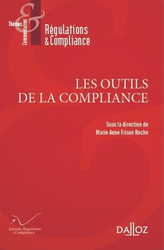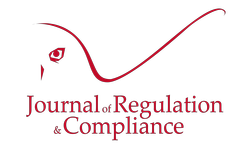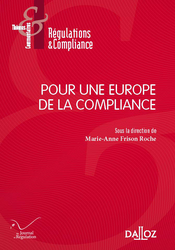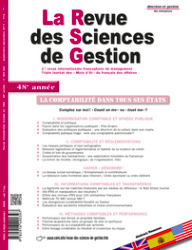April 21, 2021
Editorial responsibilities : Direction of the collection "Regulations & Compliance", JoRC & Dalloz

🌐 follow Marie-Anne Frison-Roche on LinkedIn
🌐 subscribe to the Newsletter MAFR Regulation, Compliance, Law
____
► Full Reference: M.-A. Frison-Roche (ed.), Les outils de la Compliance, coll. "Régulations & Compliance", Journal of Regulation & Compliance (JoRC) & Dalloz, 2021, 323 p.
____
📘In parallel, the English version of this book, Compliance Tools, is published in the collection co-published by the Journal of Regulation & Compliance (JoRC) and Bruylant.
____
📅This book comes after a cycle of colloquia organised by the Journal of Regulation & Compliance (JoRC) and its Academic Partners.
____
This volume is the continuation of the books dedicated to Compliance in this collection.
📚Read the other books ' presentations of the collection about Compliance:
📕 M.-A. Frison-Roche (ed.), La juridictionnalisation de la Compliance, 2023
📕 M.-A. Frison-Roche (ed.), Les Buts Monumentaux de la Compliance, 2022
📕 M.-A. Frison-Roche (ed.), Pour une Europe de la Compliance, 2019
📕 N. Borga, J.-Cl. Marin, J.-Ch. Roda (ed.), Compliance : l'Entreprise, le Régulateur et le Juge, 2018
📕 M.-A. Frison-Roche (ed.), Régulation, Supervision, Compliance, 2017
📕 M.-A. Frison-Roche (ed.), Internet, espace d'interrégulation, 2016
📚Read the presentations of the other titles of the collection.
____
► General presentation of the book: The political dimension of Compliance Law resides in the monumental goals that it aims for and which define it. These goals are internalized in "crucial operators", who willingly or by force must structure themselves and act to achieve "monumental goals", as set by public authorities and which may coincide with the interests of the enterprise. This one designs and controls the Ex Ante reorganization that this implies, under the public authorities supervision. Enterprises, even if their activities are not regulated, thus become transparent and must show the Compliance Tools effectively deployed to effectively achieve these goals. It is a major transformation of economic life in all countries because the Compliance Tools are adopted everywhere and have a global effect.
These appear to be very diverse but their unity is profound and bringing it out has the practical benefit of producing a legal regime that is as unified as possible, while allowing their adaptation country by country, sector by sector, enterprise by enterprise.
This book aims to understand these Compliance Tools to better anticipate the assessment that will be made by Regulators, Supervisors and Courts, as well as the new conceptions of the authors of legal texts which impose new ones every day, while companies must also imagine the most appropriate Compliance Tools.
This collective work specifically apprehends those on which we have few studies when we handle them on a daily basis, such as risk mapping or training or rights, letting more familiar tools shine through more transversal contributions, such as compliance programs, sanctions, whistleblowing or many sorts of settlements, agreements of public interest.
A first chapter takes a legal and economic approach. A second chapter emphasizes the role of risk mapping. A third chapter draws the game of incentives. A fourth chapter identifies the expertise required. A fifth chapter insists on geographic significance. A sixth chapter details the measurement of effectiveness. A seventh chapter explores training. The eighth chapter examines technological tools. The concluding article leads to rights.
____
► Read the general introduction of the book (in French).
____
► Understand the book through the Table of Contents and the summaries of each article:
INTRODUCTION
🕴️M.-A. Frison-Roche, 📝Décrire, concevoir et corréler les outils de la compliance, pour en faire un usage adéquat
I. APPROCHES JURIDIQUE ET ÉCONOMIQUE DES OUTILS DE LA COMPLIANCE (LEGAL AND ECONOMIC APPROACHES TO COMPLIANCE TOOLS)
🕴️M.-A. Frison-Roche, 📝Approche juridique des outils de la compliance. Construire juridiquement l'unité des outils de la compliance à partir de la définition du Droit de la compliance par ses "buts monumentaux"
🕴️L. Benzoni et 🕴️B. Deffains, 📝Approche économique des outils de la compliance : finalité, mesure, effectivité de la compliance "subie" et "choisie"
II. LA CARTOGRAPHIE DES RISQUES, OUTIL CENTRAL DE LA COMPLIANCE (RISK MAPPING, CENTRAL COMPLIANCE TOOL)
🕴️M.-A. Frison-Roche, 📝Dresser des cartographies des risques comme obligation et le paradoxe des "risques de conformité"
🕴️N. Guillaume, 📝Cartographie des risques de compliance. Premiers aperçus des enjeux, des limites et des bonnes pratiques
III. PLACE ET MANIEMENT DES INCITATIONS DANS LES SYSTÈMES DE COMPLIANCE (PLACE AND USE OF INCENTIVES IN COMPLIANCE SYSTEMS)
🕴️L. Rapp, 📝Théorie des incitations et gouvernance des activités spatiales
🕴️M.-A. Frison-Roche, 📝Résoudre la contradiction entre "sanction" et "incitation" sous le feu du Droit de la compliance
🕴️M. Larouer, 📝La manifestation des mécanismes incitatifs dans le droit français de la compliance
🕴️H. Tardieu, 📝Souveraineté des données et compliance
🕴️L. Calandri, 📝Incitation(s) et autorégulation(s) : quelle place pour le droit de la compliance dans le secteur audiovisuel?
🕴️M.-A. Frison-Roche, 📝Compliance et incitations : un couple à propulser
IV. LES EXPERTISES REQUISES EN MATIÈRE DE COMPLIANCE (THE REQUIRED EXPERTISES IN TERMS OF COMPLIANCE)
🕴️A. Gutierrez-Crespin, 📝L’audit du dispositif de compliance : un outil clé pour en vérifier la robustesse
🕴️S. Koenigsberg et 🕴️Fr. Barrière, 📝La construction de l'expertise de l'avocat en matière de compliance
🕴️Th. Amico, 📝La Compliance ou le passage de l'ex post à l'ex ante. Une révolution copernicienne pour l'avocat pénaliste ?
V. LA PRÉGNANCE GÉOGRAPHIQUE DES OUTILS DE LA COMPLIANCE (THE GEOGRAPHICAL DOMINANCE OF COMPLIANCE TOOLS)
🕴️J.-B. Racine, 📝Propos introductifs. La prégnance géographique dans le choix et l'usage des outils de la compliance
🕴️M. M. Salah, 📝Conception et application de la compliance en Afrique
🕴️R. Burlingame, 🕴️K. Coppens, N. Power et 🕴️D.H. Lee, 📝Compliance : lutte internationale contre la corruption et gestion des risques
VI. LA MESURE DE L'EFFECTIVITÉ DES OUTILS DE LA COMPLIANCE (THE MEASURE OF COMPLIANCE TOOLS EFFECTIVITY)
🕴️M. Galland, 📝Le contrôle par le régulateur de l'effectivité des instruments de compliance mis en place par l'entreprise
🕴️A. Banck, 📝La maturité de l’utilisateur d'un outil de compliance, premier critère du choix de l’outil adéquat
VII. LA FORMATION, ALPHA ET OMÉGA DE LA COMPLIANCE (TRAINING, ALPHA AND OMEGA OF COMPLIANCE)
🕴️H. Causse, 📝La compliance : par et au-delà de la formation juridique classique
🕴️M.-A. Frison-Roche, 📝La formation : contenu et contenant de la compliance
🕴️Th. Thouret, 📝Formation et compliance : deux outils corrélés de transmission d'information
VIII. LES OUTILS TECHNOLOGIQUES ET LA COMPLIANCE BY DESIGN (TECHNOLOGICAL TOOLS AND COMPLIANCE BY DESIGN)
🕴️J.-Ch. Roda, 📝La compliance by design en antitrust : entre innovation et illusion
🕴️C. Granier, 📝L'originalité normative de la compliance by design
🕴️L. Pailler, 📝Les outils technologiques, la compliance by design et le RGPD : la protection des données dès la conception
🕴️S. Merabet, 📝La morale by design
CONCLUSION
🕴️M.-A. Frison-Roche, 📝Les droits subjectifs, outils premiers et naturels du Droit de la compliance
________

June 18, 2019
Organization of scientific events

As the previous cycles devoted to the general theme of Compliance and aiming to build a "Compliance Law", having the same vocation to be published in the series Regulation & Compliance, co-published by the Journal of Regulation & Compliance (JoRC) and the Editions Dalloz, this cycle takes a particular aspect of this branch of the Law being built and developed, which was applied even before being conceived. Since pragmatism preceded or even prevailed, the theme chosen this year is: Les outils de la Compliance (Compliance Tools).
These conferences will be in French
These tools are very diverse, not only among themselves but according to the sectors in which they are deployed or according to the geographical areas in which they are applied. It is necessary to apprehend them by going beyond the description of the instrument literally shown, as the texts or the promoters show it, without immediately going up to too large generalities. For this reason, some conferences will focus on specific, well-identified mechanisms, such as risk mapping or alert. They may also consider how Compliance Law uses more general tools to achieve its goals, such as lawsuits, incentives or new technologies. This will make it possible to problematize more clearly perceptible difficulties in Compliance Law, such as the adequacy or inadequacy of the constraint in relation to the aims, the consideration or not of the legal and political geography, the articulation or not of the tools between them.
These various conferences will take place in several places, according to the part taken by the different university structures that this year contribute to the Journal of Regulation & Compliance (JoRC) for the realization of the cycle. The result will be two books, one in French: Les outils de la Compliance, the other in English: Compliance Tools.
This cycle of conferences about Compliance tools will begin in November 2019 and will last until June 2020.
- First conference: 28 November 2019, La cartographie des risques (Risk Mapping), Sciences po. This conference will be in French. Its publication will be in French and in English.
- Conditions of inscription (in French).
- Calendar of the entire conferences.
Le Journal of Regulation & Compliance (JoRC) works with :
- The School of Public Affairs of Sciences Po,
- The Department of Economics of Sciences po,
- The École de Droit of the Panthéon-Sorbonne University (Paris I),
- The École doctorale de Droit privé of Panthéon-Assas University (Paris 2),
- The Centre Perelman of l'Université Libre de Bruxelles,
- The GREDEG of the Sophia-Antipolis University (Nice),
- The Centre Louis Josserand of the Faculté Lyon III.
- The Faculté de Droit of Toulouse,
- TheFaculté de Droit of Clermont-Ferrand.
This cycle of conferences is supported by :
May 29, 2019
Editorial responsibilities : Direction of the collection "Regulations & Compliance", JoRC & Dalloz

♾️ follow Marie-Anne Frison-Roche on LinkedIn
♾️ subscribe to the Newsletter MAFR Regulation, Compliance, Law
____
► Full Reference: M.-A. Frison-Roche (ed.), Pour une Europe de la Compliance (For the Europe of the Compliance), series "Régulations & Compliance", Dalloz, 2019, 124 p.
____
This volume is the continuation of the books dedicated to Compliance in this collection.
📚Read the other books' presentations of the collection about Compliance:
🕴️M.-A. Frison-Roche (ed.), 📕La juridictionnalisation de la Compliance, 2023
🕴️M.-A. Frison-Roche (ed.), 📕Les Buts Monumentaux de la Compliance, 2022
🕴️M.-A. Frison-Roche (ed.), 📕Les outils de la Compliance, 2021
🕴️N. Borga, 🕴️J.-Cl. Marin &🕴️J.-Ch. Roda (ed.), 📕Compliance : l'Entreprise, le Régulateur et le Juge, 2018
🕴️M.-A. Frison-Roche (ed.), 📕Régulation, Supervision, Compliance, 2017
🕴️M.-A. Frison-Roche (ed.),📕 Internet, espace d'interrégulation, 2016
📚Read the presentations of the other titles of the collection.
____
► General presentation of the book: This book is written in French. The topic is : "For the Europe of the Compliance".
See below its general presentation in English.
The political dimension is intrinsic to the Compliance Law. Indeed, compliance mechanisms consist of internalizing in certains companies the obligation to implement goals of general interest set by Public Authorities. These public bodies control the Ex Ante reorganization that implies for these companies and punish Ex Post the possible structural inadequacy of these compagnies, becoming transparent for this purpose.
This new mode of governance establishes a continuum between Regulation, Supervision, Compliance (book published in 2017) and renew the links between Companies, Regulators and Judges!footnote-1600.
This political dimension must be increased: the Compliance Law of Compliance must today be used to build Europe.
One can observe not only the construction of the European Compliance Law, object-by-object, sector-by-sector, purpose-by-purpose, but also the construction of the European Compliance Law that transcends and unifies them. Becoming independent of American Law and ceasing to be in reaction, even on the defensive, the Compliance Law contributes to the European project, offering it a higher ambition, that Europe can carry and, by this way, can carry the Europe itself, not only to preserve the European economy from corruption or money laundering, but by claiming the protection of nature and human beings.
This is why the book describes the "reasons and objectives" of the Europe of the Compliance, which makes it possible to describe, detect and even predict the ways and means.
____
► Understand the book through the Table of Contents and the summaries of each article:
🕴️M.-A. Frison-Roche, 📝Avant propos
🕴️K. Lenaerts, 📝Le juge de l'Union européenne dans une Europe de la compliance
🕴️M.-A. Frison-Roche, 📝Un droit substantiel de la compliance, appuyé sur la tradition européenne humaniste
I. LES RAISONS ET LES OBJECTIFS D'UNE EUROPE DE LA COMPLIANCE (THE REASONS AND OBJECTIVES OF THE EUROPE OF THE COMPLIANCE)
🕴️X. Musca, 📝Construire une Europe de la compliance en donnant une meilleure place aux entreprises
🕴️P. Vimont, 📝La place de la diplomatie dans l'avancée d'une Europe de la compliance
🕴️P. Sellal, 📝Les vertus de la compliance : une réponse possible aux faiblesses de l'Union européenne ?
🕴️J.-J. Daigre, 📝Compliance, entreprise et Europe
II. LES VOIES ET MOYENS D'UNE EUROPE DE LA COMPLIANCE (THE WAYS AND MEANS OF THE EUROPE OF THE COMPLIANCE)
🕴️J.-Cl. Marin, 📝Quels outils pour la construction du droit de la compliance en Europe ?
🕴️M. Canto-Sperber, 📝La compliance et les définitions traditionnelles de la vertu
🕴️T. Bonneau, 📝Compliance et secteur bancaire et financier en Europe
🕴️C. Duchaine, 📝L'Agence française anticorruption, à l'appui de l'Europe de la compliance
🕴️D. Martin, 📝Les contraintes et les vertus de la compliance
🕴️A. de La Cotardière, 📝Construire une Europe de la compliance lisible pour les entreprises
________
Dec. 12, 2013
Thesaurus : Doctrine

Full reference: Collard, C., and Roquilly, C., Les risques juridiques et leur cartographie : proposition de méthodologie (Legal Risks and Their Mapping: proposition of Methodology), La Revue des Sciences de Gestion, vol. 263-264, no. 5, 2013, pp. 45-55.
Sciences Po's students can read this article via Sciences Po's Drive in the folder MAFR - Regulation & Compliance
May 21, 2009
Publications

Référence complète : FRISON-ROCHE, Marie-Anne, Le droit est-il un outil ou un obstacle à la régulation des infrastructures essentielles ? in Economie et droit de la régulation des infrastructures. Perspectives des pays en voie de développement, Banque Mondiale / Chaire régulation, coll. Droit et Economie, LGDJ, Paris, 2008, p. 37-49.
La Banque mondiale a montré que le développement économique des pays est lié à son développement juridique. Cela est aussi vrai pour les réseaux d'infrastructures, qui ne dépendent pas seulement des politiques publiques, mais encore du droit car il s'agit de biens essentiels pour lesquels il faut avoir un droit d'accès. Mais les pays en voie de développement souffrent d'une immaturité juridictionnelle car ils ne disposent pas d'une organisation juridictionnelle fiable et impartiale, alors que le droit a besoin d'un juge. On peut songer à deux pistes de solution : soit un tribunal internalisé dans le régulateur, sur le modèle de l'OMC, soit des pouvoirs et des taches de régulation confiées aux gestionnaires de réseau en ce qu'ils sont des "opérateurs cruciaux".
Lire la présentation générale de l'ouvrage dans lequel l'article a été publié.
Lire le résumé de l'article ci-dessous.